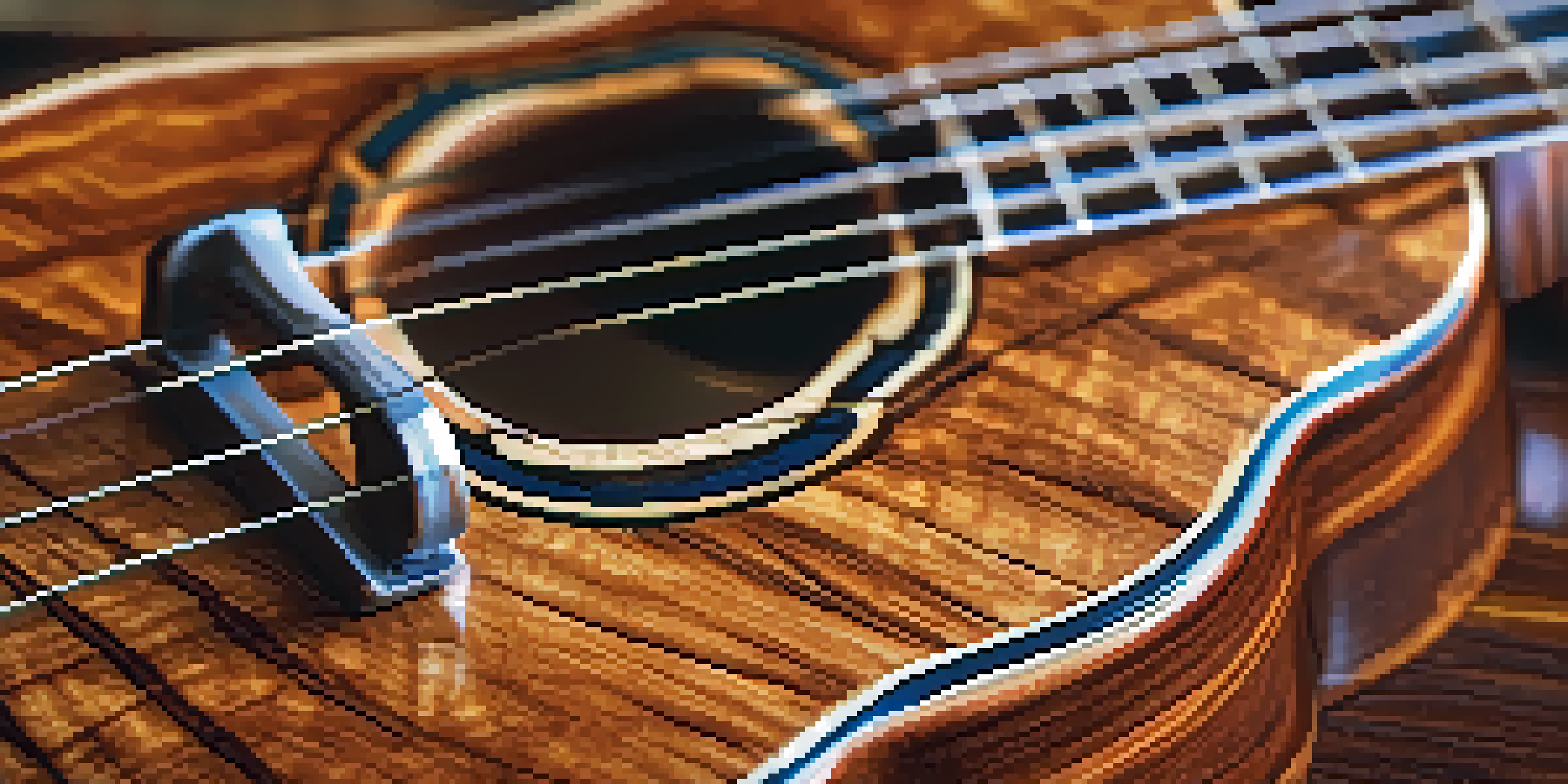Crafting the Perfect Ukulele: Insights from Industry Experts

The Art of Selecting Quality Wood for Ukulele Construction
Choosing the right wood is crucial in crafting a ukulele that sounds great. Popular choices like mahogany, spruce, and koa each bring unique tonal qualities. Mahogany offers a warm, mellow sound, while spruce tends to provide bright, clear tones. Koa, on the other hand, is known for its beautiful aesthetics and rich sound, making it a favorite among many luthiers.
The quality of the wood is essential to the quality of the sound.
Experts recommend considering the ukulele's intended use when selecting wood. For example, if you're looking for a ukulele that will be played outdoors, a more durable wood might be best. However, if you’re prioritizing sound quality for recording, a high-grade tonewood will elevate your sound. Ultimately, the right wood can significantly impact your instrument's overall performance.
Additionally, understanding the grading of wood is essential. Higher-grade woods, which are often more expensive, can enhance the instrument’s resonance and longevity. However, many luthiers have crafted beautiful-sounding ukuleles from lower-grade woods, proving that skill and craftsmanship can often outweigh material cost.
Designing the Ukulele: Shape and Size Considerations
The shape and size of a ukulele can greatly influence its sound and playability. Traditional soprano ukuleles are smaller and produce a bright, cheerful tone, while tenor and baritone ukuleles offer deeper sounds and a larger body. The choice between these sizes often comes down to personal preference and the type of music you wish to play.

Moreover, the design elements such as the body shape can affect both aesthetics and performance. A cutaway design allows for easier access to the higher frets, making it a favorite among soloists. Meanwhile, a rounded body shape can enhance projection and volume, which is perfect for group performances or outdoor settings.
Choosing the Right Wood Matters
The type of wood selected for a ukulele significantly influences its sound quality and performance.
Incorporating personal touches into the design, like unique inlays or custom finishes, can also make your ukulele stand out. This not only adds visual appeal but can also reflect the player's personality and style, making the instrument truly one-of-a-kind.
The Importance of Craftsmanship in Ukulele Production
Craftsmanship is at the heart of creating a high-quality ukulele. Skilled luthiers pay meticulous attention to detail, ensuring every joint, curve, and finish is flawless. This dedication to the craft can make a significant difference in sound quality and playability, setting professional instruments apart from mass-produced ones.
Craftsmanship is not just about making something; it’s about making something beautiful and functional.
Many industry experts emphasize that the process of building a ukulele requires patience and precision. From selecting the right materials to shaping the wood and assembling the parts, each step contributes to the final product. A well-crafted ukulele not only sounds better but also lasts longer, making it a worthwhile investment for musicians.
Additionally, the level of craftsmanship often reflects the luthier's passion for music. Many builders are musicians themselves, which gives them a unique perspective on what makes an instrument truly resonate with players. This passion can lead to innovations in design and construction techniques that enhance the overall playing experience.
Finishing Touches: Staining and Sealing Your Ukulele
The finishing process is vital for both aesthetics and protection of your ukulele. Staining can enhance the wood's natural grain and color, allowing for a more personalized look. Luthiers often experiment with different stains to achieve unique appearances, showcasing the beauty of the wood while ensuring it aligns with the player's style.
Sealing the ukulele is equally important, as it protects the wood from moisture and environmental damage. A good sealant can prevent warping and cracking, extending the life of the instrument. Moreover, the type of finish used can influence the sound; for instance, a thinner finish might allow for better resonance compared to a thicker one.
Craftsmanship Enhances Quality
Meticulous craftsmanship is essential for producing ukuleles that sound great and last longer.
Finally, the curing process is essential for ensuring that the finish adheres properly. Many luthiers recommend allowing the finish to cure fully before playing the instrument. This patience pays off, as a well-finished ukulele will not only look stunning but will also perform beautifully for years to come.
String Selection: Finding the Right Strings for Your Ukulele
Choosing the right strings can drastically alter your ukulele's tone and playability. Various materials, such as nylon, fluorocarbon, and gut, each produce different sounds. Nylon strings are popular for their warm tones, while fluorocarbon strings provide a brighter, more articulate sound, making them a favorite among many players.
Additionally, string gauge is another factor to consider. Lighter gauge strings are easier to play but may produce less volume, while heavier strings offer a fuller sound at the cost of being slightly harder on the fingers. Finding the right balance between playability and sound quality is key to enhancing your ukulele experience.
It’s also worth noting that personal preference plays a significant role in string selection. Many musicians will try several types before settling on their favorites. As you get to know your ukulele, experiment with different strings to find the combination that best suits your playing style and musical genre.
Tuning Your Ukulele: Tips from the Pros
Tuning is an essential part of playing the ukulele, and getting it right can make a world of difference. Most ukuleles are tuned to G-C-E-A, which is often referred to as standard tuning. Knowing how to tune your instrument properly is crucial for achieving the best sound and ensuring that your music is harmonious.
Experts recommend using an electronic tuner for accuracy, especially for beginners. These devices can quickly show you whether each string is in tune, making the process straightforward. With practice, however, many players become adept at tuning by ear, developing a deeper connection with their instrument.
Regular Maintenance is Key
Proper maintenance, including cleaning and string changes, is crucial for keeping your ukulele in top condition.
Additionally, it's important to regularly check your ukulele's tuning, especially after changes in temperature or humidity. Wood is sensitive to environmental changes, which can cause strings to go out of tune. By staying on top of tuning, musicians can ensure their ukuleles always sound their best, ready for any impromptu jam session.
Maintenance Tips to Keep Your Ukulele in Top Shape
Proper maintenance is key to ensuring the longevity of your ukulele. Regular cleaning, such as wiping down the strings and body after each use, can prevent build-up of dirt and grime. Additionally, storing your ukulele in a protective case can shield it from temperature fluctuations and physical damage.
Luthiers recommend performing periodic checks on the instrument's hardware, such as tuning pegs and frets, to ensure everything is functioning smoothly. If any parts show signs of wear, addressing those issues promptly can prevent further damage and maintain sound quality. Regular maintenance can save you from costly repairs down the line.

Lastly, consider changing the strings regularly based on how often you play. Worn-out strings can sound dull and lifeless, impacting your overall playing experience. By following these maintenance tips, you can keep your ukulele sounding great and looking beautiful for years to come.